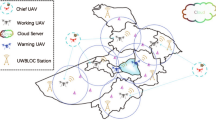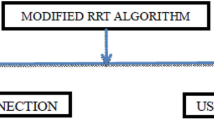Abstract
An online rectangle based scheduling algorithm (RSA) is developed to improve autonomy of multiple unmanned aerial vehicles (UAVs) to search a field of forest together. The purposes of RSA are to online decide the number of the UAVs to be assigned and to schedule the path for the assigned UAVs to search the missed areas resulted from the previous search. The main ideas of RSA are to cover each separated zone of the missed areas with a rectangle and then to schedule the path to search the rectangles. Thus, RSA is robust against the unknown shapes and sizes of the missed areas. The forest search is applied to verify the online RSA in simulation. The simulation results demonstrate that the online RSA is successful to decide the number of the UAVs to be assigned and to schedule the path for the assigned UAVs to search the missed areas.
Similar content being viewed by others
References
Altmann A, Niendorf N, Bednar M, et al. Improved 3D interpolation-based path planning for a fixed-wing unmanned aircraft. J Intell Robot Syst, 2014, 76: 185–197
Bellingham J, Tillerson M, Alighanbari M, et al. Cooperative path planning for multiple UAVs in dynamic and uncertain environments. In: Proceedings of the 41st IEEE Conference on Decision and Control, Las Vegas, 2002. 2816–2822
Chen Y, Yu J, Su X, et al. Path planning for multi-UAV formation. J Intell Robot Syst, 2015, 77: 229–241
Kaminer I, Yakimenko C, Pascoal A, et al. Path generation, path following and coordinated control for timecritical missions of multiple UAVs. In: Proceedings of American Control Conference, Minneapolis, 2006. 4906–4913
Richards A, Bellingham J, Tillerson M, et al. Coordination and control of multuple UAVs. In: Proceedings of AIAA Guidabce, Navigation abd Control Conference amd Exhibition, Monlerey, 2002. 2002–4588
Cai H, Huang J. Leader-following adaptive consensus of multiple uncertain rigid spacecraft systems. Sci China Inf Sci, 2016, 59: 010201
Ren W, Beard R. On consensus algorithm for double-integrator dynamics. IEEE Trans Autom Control, 2008, 53: 1503–1509
Chen J, Gan M G, Huang J, et al. Formation control of multiple euler-lagrange systems via null-space-based behavioral control. Sci China Inf Sci, 2016, 59: 010202
Inalhan G, Stipanovic D, Tomlin C. Decentralized optimization with application to multiple aircraft coordination. In: Proceedings of the 41st IEEE International Conference on Decision and Control, Las Vegas, 2002. 1147–1155
Lafferriere G, Williams A, Caughman J, et al. Decentralized control of vehicle formations. Syst Control Lett, 2005, 54: 899–910
Liu H Y, Sun F C, Wang S Q. Virtual strategy QoS routing in satellite networks. Sci China Inf Sci, 2016, 59: 092201
Tomlin C J, Pappas G J, Sastry S S. Conflict resolution for air traffic management: a case study in multi-agent hybrid systems. IEEE Trans Autom Control, 1998, 43: 509–521
Beard R, Mc Lain T. Multiple UAV cooperative search under collision avoidance and limited range communication constraints. In: Proceedings of the 42nd IEEE International Conference on Decision and Control, Maui, 2003. 25–30
Ren W, Beard R. Consensus seeking in multiagent systems with dynamically changing interaction topologies. IEEE Trans Autom Control, 2005, 50: 655–661
Chrpa L, Osborne H. Towards a trajectory planning concept: augmenting path planning methods by considering speed limit constraints. J Intell Robot Syst, 2014, 76: 243–270
Jadbabaic A, Lin J, Morse A S. Coordination of groups of mobile autonomous agents with neighbor rules. IEEE Trans Autom Control, 2003, 48: 998–1001
Kogan K, López-Ortiz A, Nikolenko S I, et al. Online scheduling FIFO policies with admission and push-out. Theory Comput Syst, 2016, 58: 322–344
Wongpiromsarn T, Topcu U, Murray R M. Synthesis of control protocols for autonomous systems. Unmanned Syst, 2013, 1: 21–39
Kopeikin A N, Ponda S S, Johnson L B, et al. Dynamic mission planning for communication control in multiple unmanned aircraft teams. Unmanned Syst, 2013, 1: 41–58
Leoff J, Ackermann H, Küfer K H. Time-hierarchical scheduling. J Sched, 2016, 19: 215–225
Peng K, Pang T, Lin F, et al. Autonomous mission execution for multiple unmanned aerial vehicles with hierarchicaldistributed methodology. In: Proceedings of the 11th IEEE International Conference on Control and Automation, Taichung, 2014. 1369–1374
Zhang B, Mao Z, Liu W, et al. Geometric reinforcement learning for path planning of UAVs. J Intell Robot Syst, 2015, 77: 391–402
Cailhol S, Fillatreau P, Fourquet J Y, et al. A hierarchic approach for path planning in virtual reality. Int J Interact Des Manuf, 2015, 9: 291–302
Chen H, Lee J. Path planning of 5-DOF manipulator based on maximum mobility. Int J Precis Eng Manuf, 2014, 15: 45–52
Lim S H, Han C S. Operational space path planning of the dual-arm robot for the assembly task. Int J Precis Eng Manuf, 2014, 15: 2071–2076
Doherty P, Heintz F, Kvarnström J. High-level mission specification and planning for collaborative unmanned aircraft systems using delegation. Unmanned Syst, 2013, 1: 75–119
Epstein L, Jez L, Sgall J, et al. Online scheduling of jobs with fixed start times on related machines. Algorithmica, 2016, 74: 156–176
Li W, Yuan J. LPT online strategy for parallel-machine scheduling with kind release times. Optim Lett, 2016, 10: 159–168
Liu H, Yuan J, Li H. Online scheduling of equal length jobs on unbounded parallel batch processing machines with limited restart. J Comb Optim, 2016, 31: 1609–1622
Xu J, Liu Z H. An optimal online algorithm for scheduling on two parallel machines with GoS eligibility constraints. Oper Res Soc China, 2016, 4: 371–377
Putzer H, Onken R. COSA — a generic cognitive system architecture based on a cognitive model of human behavior. Cogn Tech Work, 2003, 5: 140–151
Uhrmann J, Schulte A. Task-based guidance of multiple UAV using cognitive automation. In: Proceedings of International Conference on Advanced Cognitive Technologies and Applications, Rome, 2011. 47–52
Tchernykh A, Lozano L, Schwiegelshohn U, et al. Online bi-objective scheduling for iaas clouds ensuring quality of service. J Grid Comput, 2016, 14: 5–22
Deb S, Fong S, Tian Z, et al. Finding approximate solutions of NP-hard optimization and TSP problems using elephant search algorithm. J Supercomput, 2016, 72: 3960–3992
Laporte G. The traveling salesman problem: an overview of exact and approximate algorithms. Eur J Oper Res, 1992, 59: 231–247
Author information
Authors and Affiliations
Corresponding author
Rights and permissions
About this article
Cite this article
Peng, K., Lin, F. & Chen, B.M. Online schedule for autonomy of multiple unmanned aerial vehicles. Sci. China Inf. Sci. 60, 072203 (2017). https://doi.org/10.1007/s11432-016-9025-9
Received:
Accepted:
Published:
DOI: https://doi.org/10.1007/s11432-016-9025-9




